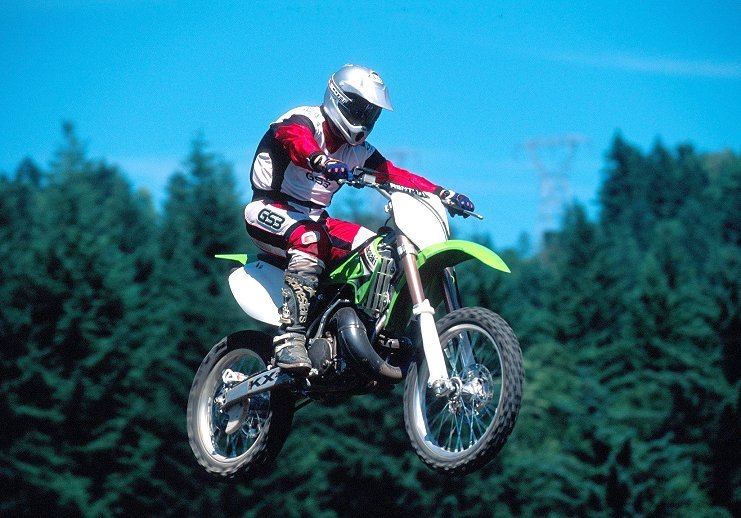
When Kawasaki invited MD to Washougal, Washington to test the 2003 KX125 and KX250, it was an exciting opportunity for a couple of reasons. First of all, Washougal is a legendary track that I had never ridden (and never dreamed of riding, really), and the 2003 KXs were entirely new (from the ground up, in the case of the 125).
Before getting into my experience riding the new KXs at Washougal, let’s discuss a little background of these all-new motocrossers from Kawasaki. Readers should take a look at our preview article dated June 1, 2002, and note a couple of other interesting aspects of the new KX designs.
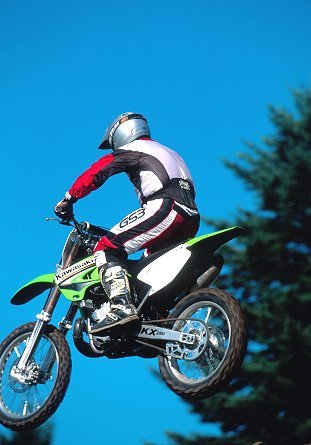
As stated, the 2003 KX125 is entirely new, including a redesigned engine. The KX125 has been renowned for its handling for a number of years, but has fallen short in the engine performance department, particularly, stock. Modified KX125s have virtually dominated professional racing at the hands of Ricky Carmichael and, more recently, James Stewart. Nevertheless, the stock motor needed some work to come up to a competitive level with the other Japanese manufacturers and KTM.
The new motor has so many changes that it is difficult to discuss them all. We hope to get a 125 for a more thorough test a bit later, but we do have to highlight some technical aspects of the new machine in connection with this first riding impression.
A few years ago, some manufacturers experimented with 38mm carburetors on 125cc motocross machines, with mixed success. Basically, it is a challenge to maintain adequate low-end and mid-range engine performance with a huge, 38mm carburetor on a 125. A boost in top end power is almost a given, but it is difficult to maintain crisp throttle response, and adequate intake velocity, at lower rpm levels. Basically, Kawasaki was stuck with a 36mm carb on its prior 125cc models.
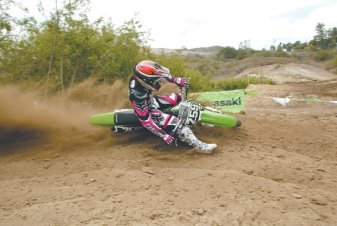
James Stewart likes the new KX125, too
The new 125cc engine, with its completely redesigned cylinder, piston and exhaust valve system, among other changes, sports a very trick Mikuni TMx 38 carburetor, which is not only 38mm, but features a unique arch-shaped slide (see picture) which concentrates the incoming fuel/air mix towards the center of the intake tract.
Sending the exhaust through a new pipe that, by appearance, seems to have a huge volume for a 125cc machine, the resulting engine performance is outstanding (more discussion of this below).
Chassis changes shared by the two machines are discussed in our preview article. These include the all-new perimeter frame (that differs only in the design of the engine cradle between the 125 and the 250), as well as the new, lighter hydroformed swingarm, new, lighter rear hub (pictured), etc. Basically, Kawasaki pushed hard to make the 2003 models as light and as strong as possible. Despite a lighter weight frame, for instance, frame rigidity is up over last year.
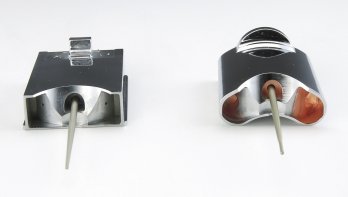
Ergonomics can be summed up by looking at two goals successfully focused on by Kawasaki, including a slim, catch-free profile (your boots won’t snag anywhere on these bikes) and freedom of movement for the rider.
On a beautiful Washougal track, both bikes were very impressive. Focusing on the 125 first, we have to say that this bike simply blew us away.
Without a competitor’s 125 to ride side-by-side, it is difficult to draw conclusions, but the new KX125 is very, very fast. Despite that huge carburetor, Kawasaki succeeded in giving the KX125 a broad, easy-to-use powerband as well. Whether exiting corners a gear higher than you might on most 125s, or holding the power on to stretch a gear a bit farther than you might otherwise want to, the 2003 KX125 does exactly what you want it to do. It keeps pulling . . . with authority!
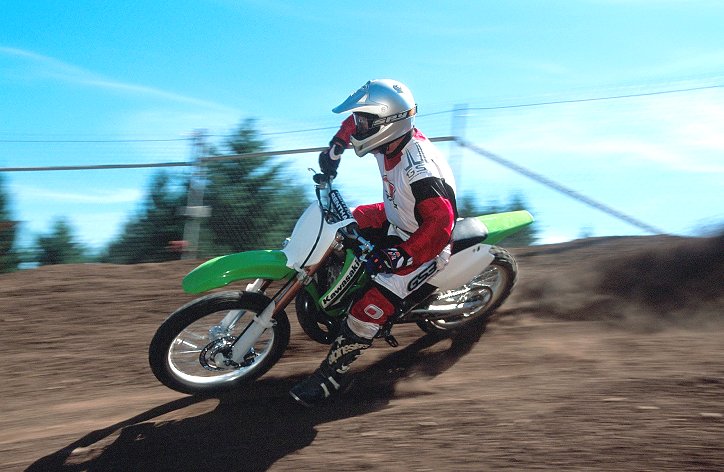
I was so impressed with the engine power of the new KX125 that I took the bike over to the starting blocks, planted my 200 pound frame on top, clicked the transmission into second gear, and practiced a few starts. If a stock 125 will pull second gear starts with a large rider aboard, it is a sure indication that the bike has some serious horsepower and torque. The KX125 pulled second gear starts quite easily. Let’s end this discussion of engine performance by saying, at this point, we think the 2003 KX125 is going to be fighting for the title of the most powerful stock 125 available this year.
The handling of the 2003 KX125 was impressive, as well. The bike feels small and more responsive to cornering inputs than last year’s model. Kawasaki clearly wanted to make the bike lighter and more nimble, but wanted to make sure, at the same time, that its well-deserved reputation for stability continued. As far as we can tell at this point, Kawasaki nailed it. The new 125 corners quickly, goes where you point it, and doesn’t shake its head. It definitely feels smaller and lighter than last year’s model, as well (it is a claimed six pounds lighter).
The rider could move freely on the KX125 without worrying about getting hung up on the side panels of the machine (something Kawasaki was very careful about in the new design), and the shape of the new seat facilitates weighting the front end in corners. The bars felt a bit close on the 125, but not bad. Bar position, of course, can always be changed with a different bar bend or, if necessary, after-market triple clamps and a new bar.
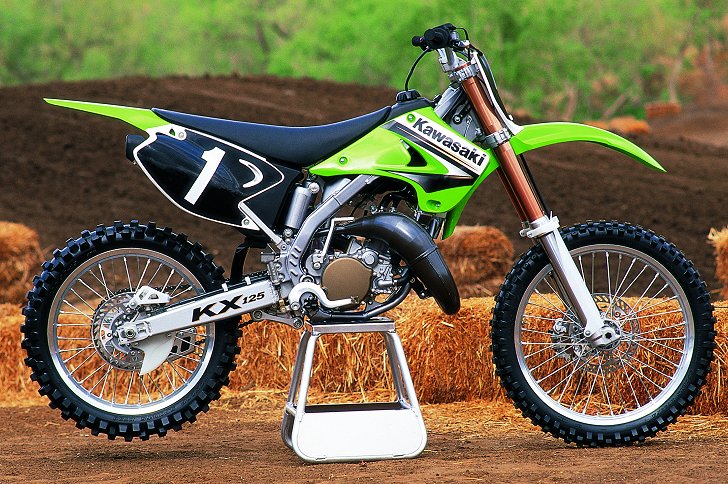
In general, I was able to ride the 125 without thinking too much about the bike — focusing on the new (for me) track. This is exactly what you want a bike to do. The suspension facilitated this by offering good compliance without bottoming under my girth.
A brief story about a portion of the track can illustrate some of the above-comments. There is a fairly large table-top at Washougal with a tunnel underneath it. Clearing this table-top on the KX125 requires wide open throttle in third gear (or an approach with a slightly trailing throttle in fourth gear). Just prior to this jump, the rider must load the suspension and seat bounce (or simply clear while standing) a small gap in the track, and then continue towards the face of the jump. Several times, the KX125 landed slightly short of completely clearing this gap in the track before approaching the jump face. The suspension soaked up the track (I was probably close to bottoming the rear suspension at this point) without kicking the bike sideways, and allowing me to get back on the throttle hard while approaching the jump face. This is exactly the type of situation where poorly tuned suspension will result in head shake or a serious swap from the rear end. Both the new KX125 and the KX250 handled this with a shrug, however — no big deal.
Kawasaki has thankfully retained a six-speed gear-box with its new 125. While five speeds might be plenty for most motocross tracks, the six-speed box is an advantage for two reasons. First of all, many riders want to use their 125 for more than just motocross. Second, even on a motocross track, a six-speed transmission allows you to tighten your gearing, if necessary, for tight tracks.
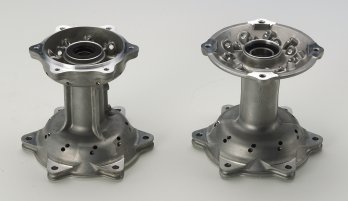
That transmission worked fine — again, it was something I didn’t think about too much while riding the bike. It did exactly what I asked it to do, and I do not recall missing a shift on the 125.
The 2003 KX250 has all of the significant chassis upgrades featured on the 2003 KX125, but the motor is not “all new”, although it is extensively revised. Again, without a competitor’s 250 to ride back-to-back, the 2003 KX250 engine seemed superb. Frankly, last year’s motor was good, but it was a bit soft on peak torque and peak horsepower compared to some of the competition. Its strength was smooth, tractable power. The 2003 retains the smooth, tractable characteristics, but seems to have a huge boost in torque and horsepower versus last year’s model.
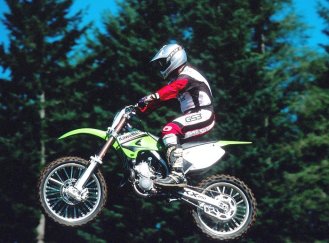
The 250 was very flexible. Second gear corners could be third gear corners if you so chose. The bike pulls very well off the bottom, but seems to rev out nicely, as well. The KX250 ate the steep uphill at Washougal like it wasn’t there (the new 125 pulled this hill impressively, in its own right). For most amateur riders, the new KX250 is going to have more motor than they need, and it should have a lot more to offer pro-level riders this year.
The KX250 did seem to have a small stumble right off idle, but it was not something noticeable unless you were in cruise mode. I did not play with the air screw, but this might have done the trick. Overall, there is very little to complain about with regard to the new KX250 engine. If you are expecting anything like last year’s motor, you will be shocked at the increase in boost.
The 250 handles very well for its class, also. Sharing the same basic frame with the 125 means the 250 has virtually identical ergonomics. The bike is slender and small-feeling compared with last year’s model and, like the 125, makes the rider feel that he is much closer to the front end of the bike. This is a feeling that creates confidence in corners.
The transmission on the 250 felt a bit notchier than the 125, but it was positive and did not find false neutrals while I rode it. Gear spacing seems good (this was tweaked a bit by Kawasaki, this year). Basically, with the additional power, and the breadth of the new powerband, gear selection is not real critical on the new KX250, in any event.
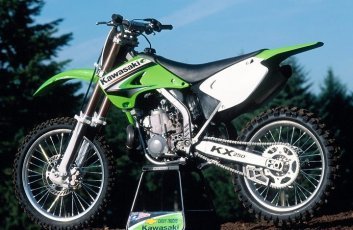
The suspension did not seem quite as balanced for me on the 250, but this could have something to do with my weight. Stock springs are always a compromise, designed for “average sized” riders. A stiffer shock spring would have raised the rear of the 250 a bit, and allowed it to carve corners more like the 125.
One day at Washougal can only tell you so much. Each of the new KXs are clearly a big step forward over last year’s models, and appear ready to compete for the best bike in their respective classes. What stands out most for me after looking back at my press intro ride at Washougal? Frankly, the 125 blew me away. It was so easy to ride, and it seemed extremely potent for a stock 125. When thinking about the 250, its engine comes to mind, immediately. The KX250 has a mega motor this year.
Stay tuned. We are hoping Kawasaki will provide us with each of these models for more extensive testing.





